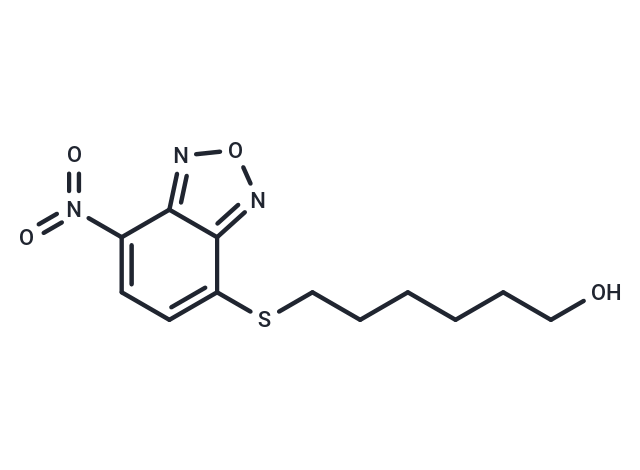Shopping Cart
- Remove All
 Your shopping cart is currently empty
Your shopping cart is currently empty

NBDHEX is a potent inhibitor of glutathione S-transferase P1-1 (GSTP1-1).

| Pack Size | Price | Availability | Quantity |
|---|---|---|---|
| 1 mg | $30 | In Stock | |
| 5 mg | $64 | In Stock | |
| 10 mg | $98 | In Stock | |
| 25 mg | $192 | In Stock | |
| 50 mg | $313 | In Stock | |
| 100 mg | $463 | In Stock | |
| 1 mL x 10 mM (in DMSO) | $71 | In Stock |
| Description | NBDHEX is a potent inhibitor of glutathione S-transferase P1-1 (GSTP1-1) . |
| In vitro | NBDHEX not only is cytotoxic toward the parental small cell lung cancer H69 cell line (LC(50) of 2.3 +/- 0.6 micromol/L) but also overcomes the multidrug resistance of its variant, H69AR, which overexpresses the ATP-binding cassette transporter multidrug resistance-associated protein 1 (MRP1;?LC(50) of 4.5 +/- 0.9 micromol/L).?Drug efflux experiments, done in the presence of a specific inhibitor of MRP1, confirmed that NBDHEX is not a substrate for this export pump [1]. |
| In vivo | NBDHEX, In female mice, treatment results in a statistically significant tumour inhibition (approximately 70%) [1]. |
| Molecular Weight | 297.33 |
| Formula | C12H15N3O4S |
| Cas No. | 787634-60-0 |
| Smiles | N(=O)(=O)C=1C=2C(C(SCCCCCCO)=CC1)=NON2 |
| Relative Density. | 1.31g/cm3 |
| Storage | Powder: -20°C for 3 years | In solvent: -80°C for 1 year | Shipping with blue ice. | |||||||||||||||||||||||||||||||||||
| Solubility Information | DMSO: 125 mg/mL (420.41 mM), Sonication is recommended. | |||||||||||||||||||||||||||||||||||
Solution Preparation Table | ||||||||||||||||||||||||||||||||||||
DMSO
| ||||||||||||||||||||||||||||||||||||

Copyright © 2015-2025 TargetMol Chemicals Inc. All Rights Reserved.